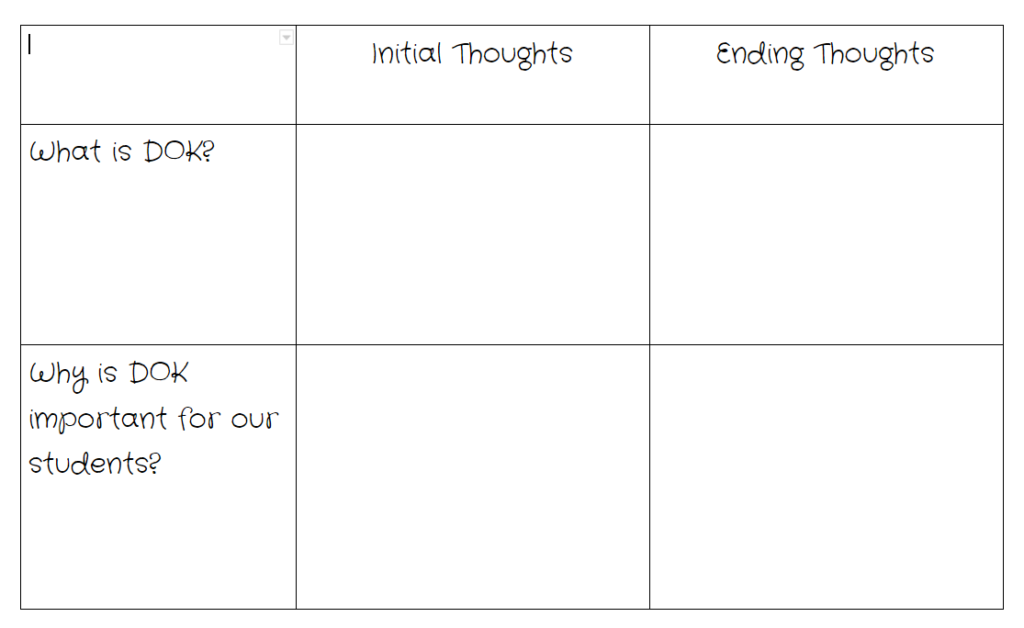Depth of Knowledge (D.O.K.): What is it? Why does it matter? Why has it been added to the already full plates of educators? To be honest, I didn’t really give D.O.K. much credit. Like many educators, it felt like it would be more work, harder assignments, and jamming more into a school day. Like many times before in my career, the adopted D.O.K. jargon kept appearing but lacked clear explanations. Clarity precedes competence and without clarity, it was difficult for me to want to put forth much effort to categorize student tasks according to the complexity of required thought.
This was my story until two things occurred. First, our corporation adopted Professional Learning Communities (PLCs) as our curriculum framework and started the process of addressing the question, “What do we want students to know?”
We spent large amounts of time deconstructing the (then new) more rigorous standards. Wow! Not all standards are created equally! Then, Indiana switched their state assessment from ISTEP+ to ILEARN, a computer adaptive test (CAT), that adjusts in difficulty while remaining consistent with D.O.K. levels for students. It then became clear I needed to dig in and increase my understanding.
What is it? Norman Webb’s D.O.K. is a framework designed to support how educators design tasks to move students beyond surface-level thinking with correlations to how extensively students share their knowledge and thinking. It gives educators a process and criteria as they work to align standards and standardized assessments. And, something I appreciate, gives educators a common language to address rigor. The framework divides the required amount of student thinking into four levels. Though the categories are labeled 1 to 4, they are not linear and should not be interpreted as steps.
In other words, a student does not need to start at level 1 and go sequentially to level 4. Sometimes a Level 3 task can give students the motivation for the upcoming learning to happen at Levels 1 and 2.
| D.O.K. 1 | Knowledge Acquisition
|
Which of these events happened first in the lives of the characters?
|
| D.O.K. 2 | Knowledge Application
|
Then a slow, black cloud rose from the caverns and ascended into the heavens.
Which of the dictionary definitions below of issue BEST fits the way the word is used in the sentence above?
|
If there is only one correct answer, it is probably level DOK 1 or DOK 2.
DOK 1: You either know it (can recall it, locate it, do it) or you don’t. A computer could likely be able to grade the work.
DOK 2: Apply one concept, then make a decision before applying a second concept. Evaluate how something functions or is used.
| D.O.K. 3 | Knowledge Analysis
|
The narrator of the novel makes numerous comments that hint at the outcome of the story. Give one example of a statement that suggests the outcome of the story. Then explain how the chosen example helps a reader predict the story’s outcome. |
| D.O.K. 4 | Knowledge Augmentation
|
If more than one solution/approach, requiring evidence, it is DOK 3 or 4.
DOK 3: Must provide supporting evidence and reasoning (not just HOW solved, but WHY – explain reasoning). Requires an element of planning before solving
DOK 4: Includes all of 3 and the use of multiple sources or texts. Addresses how else or what else.
Some overarching information about the topic includes:
-
- D.O.K. is not the same as difficulty. Difficulty refers to how many students can complete the given task completely. It addresses easy vs hard. D.O.K. refers to what kind of thinking is required and the extent they are to show what they’ve learned. It addresses simple vs complex. Complicated and complex are two different concepts not to be used interchangeably. In one of our first professional learning events, the staff did a very simple pre and post-activity: DOK Pre and Post.
Though a basic activity, what became clear was the tendency to confuse the two classifications of difficulty levels and D.O.K. Grasping the distinction between the two classifications is a great first step in diving into greater understanding.IDOE Specs – This 6-minute video shows you an amazing resource provided on the IDOE website to help educators dig into D.O.K. and difficulty for standards in grades 3-8. The information is valuable, however, for all grade level teachers seeking a better understanding.
- D.O.K. is not the same as difficulty. Difficulty refers to how many students can complete the given task completely. It addresses easy vs hard. D.O.K. refers to what kind of thinking is required and the extent they are to show what they’ve learned. It addresses simple vs complex. Complicated and complex are two different concepts not to be used interchangeably. In one of our first professional learning events, the staff did a very simple pre and post-activity: DOK Pre and Post.
-
- D.O.K. levels are not automatically increased by just adding technology. In a time where virtual learning and the use of technology are becoming increasingly more popular this message needs to be clear. The assigned task may add a level of difficulty and increased time, but D.O.K. is about the level of thinking required and the explanation of what was learned. For example, a student may create a slideshow which requires technical skills and extended time, but if they simply copy and paste information onto the slides the work is still at a D.O.K. 1.
- D.O.K. levels are not intended to be used in equal amounts. Educators are advised to live in Levels 2 and 3 and visit Levels 1 and 4. D.O.K. Levels 1 and 2 are expected to appear more in the lower grade-level standards due to the nature of the tasks required by the standards. Students do need practice in all four levels of thinking in order to prepare for real-world success, just not in equal amounts.
D.O.K. is not just about giving tasks that take more time. Educators often love doing units and projects and link them with being more complex tasks. This misunderstanding also applies to believing adding more problems to an assignment increases the challenge for students. But, repeating lower-level tasks over and over is still just doing lower-level tasks.
<li”>D.O.K. is for ALL students regardless of any demographic category. The levels will likely look different at different grade levels. Also, levels of difficulty can (and often should) be adjusted with the assignment.
In the end, the time and energy put into the processes of separating difficulty from Depth of Knowledge; understanding the intended range of rigor in standards through the deconstruction process; and seeking alignment of questions, lessons, projects, and tests has led me to my current understanding of D.O.K. My biggest takeaway has been understanding the intentionality required by educators to provide all students with opportunities to think critically on a regular basis. It is hard work, but Webb’s framework provides a tool educators can use to collaborate and organize tasks in a helpful and organized manner.




